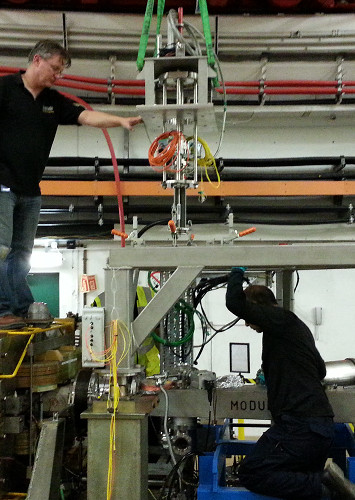MICE stands for Muon Ionisation Cooling Experiment. The experiment is a worldwide collaboration including scientists and engineers from Europe and the US. It is hosted by the Rutherford Appleton Laboratory in Didcot, using the ISIS accelerator. MICE aims to demonstrate ionisation cooling, a technique which will be essential for a future neutrino factory or muon collider.
The ionisation cooling process works by first passing muons through an energy absorbing material (the absorber) where the particles loose both longitudinal and transverse momentum. Next a set of radio frequency cavities restore the lost longitudinal momentum. The net result of this is to reduce transverse momentum, which reduces the emittance of the beam and the beam is "cooled". In addition to cooling, a heating effect is also introduced by particles scattering in the absorber, which must be minimised. In order to produce successful cooling, the following are required:
To study the cooling effect MICE also contains precise instrumentation for measuring each particle which traverses the beamline and is capable of performing an absolute measurement of emittance before and after cooling to 0.3%. This instrumentation includes:
MICE has begun data collection for the step IV of the experiment (shown below). At this stage energy loss and multiple scattering of muons passing through both Liquid Hydrogen and Lithium Hydride is being studied. Next the superconducting cooling channel magnets will be commissioned, which will allow the study of ionisation cooling without restoring lost longitudinal momentum. This will allow a precise comparison of the two absorber materials and enable a validation of the Monte-Carlo codes used to predict the performance of the cooling channel.

Once Step IV data is collected the experiment will be reworked to include an additonal two absorbers and accelerating cavities for a demonstration of the cooling process.

The Sheffield team began collaboration with MICE to build a new HEP target for ISIS Synchrotron at Rutherford Appleton Laboratory. The target is required to scrape the edge of the intense beam at the end of a 10 ms acceleration cycle and be outside the beam at the next injection cycle 10 ms later. In order to achieve this the mechanism must accelerate at 80g and stop with sub millimetre precision. In addition the mechanism must be capable of operating reliably without intervention within the hard vacuum and radiation environment of the synchrotron.
The target design is based around a linear motor, which is used to insert a titanium shaft 40 mm into the ISIS beam. There have been two iterations of the production target design the T series and an improved S series. After a through testing programme the new target S1.9 was installed on the synchrotron in December 2014, and has remained in operation since.
The Sheffield group was originally involved with the development of a target system, however since the successful completion of this the group has become involved with many other aspects. These currently include:
Dr Chris Booth, lecturer
Dr Paul Hodgson, research associate
Dr Edward Overton, research associate
Dr Scott Wilbur, research associate
Mr Joe Langlands, research student